List of amphibians and reptiles of Barbados
This is a list of amphibians and reptiles found on Barbados, a Caribbean island-nation in the Lesser Antilles. Barbados is largely flat and has been intensively cultivated for over 300 years. This has left little natural vegetation on the island, leaving most species found there restricted to narrow habitats such as wooded gullies.[1]

Amphibians
There are two species of amphibians on Barbados, at least one of which was introduced.
Frogs (Anura)
| Tropical frogs (Leptodactylidae) | |||
|---|---|---|---|
| Species | Common name(s) | Notes | Image |
| Eleutherodactylus johnstonei | Lesser Antillean whistling frog, coqui Antillano, Johnstone's whistling frog | Least Concern.[2] Widespread throughout the Lesser Antilles. Whether it was a native or introduced is a matter of controversy.[3] |  |
| True toads (Bufonidae) | |||
| Species | Common name(s) | Notes | Image |
| Bufo marinus | Cane toad, giant neotropical toad, marine toad | Least Concern. Introduced in the 1830s to control insect pests of sugarcane. Abundant and widespread, particularly in rural areas. | 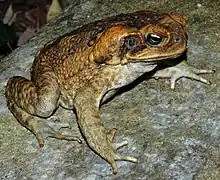 |
Reptiles
Including marine turtles and introduced species, there are 15 reptile species reported on Barbados, though two are possibly extinct. The Barbados leaf-toed gecko (Phyllodactylus pulcher) and the Barbados threadsnake (Leptotyphlops carlae) are endemic, as was the probably extinct Barbados racer (Liophis perfuscus). A fourth species, the Barbados anole (Anolis extremus), was endemic to Barbados but has been introduced to other islands.
Turtles (Testudines)
| Tortoises (Testudinidae) | |||
|---|---|---|---|
| Species | Common name(s) | Notes | Image |
| Geochelone carbonaria | Red-footed tortoise | Probably introduced. Only known in captive populations and individuals that escaped from such areas; unlikely that a viable wild population exists. | 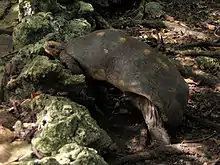 |
| Scaly sea turtles (Cheloniidae) | |||
| Species | Common name(s) | Notes | Image |
| Caretta caretta | Loggerhead turtle | Endangered. | 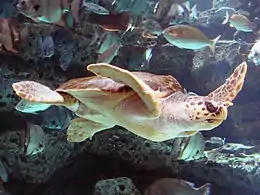 |
| Chelonia mydas | Green turtle | Endangered. Seen feeding in waters near the shore. Recorded nesting on Barbados. | 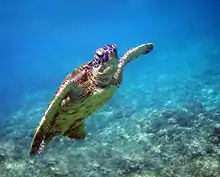 |
| Eretmochelys imbricata | Hawksbill turtle | Critically Endangered. Recorded nesting on Barbados. | 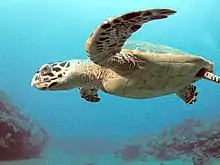 |
| Leathery sea turtles (Dermochelyidae) | |||
| Species | Common name(s) | Notes | Image |
| Dermochelys coriacea | Leatherback turtle | Critically Endangered. Recorded nesting on Barbados. | 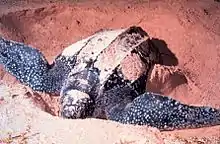 |
Lizards and snakes (Squamata)
| Geckos (Gekkonidae) | |||
|---|---|---|---|
| Species | Common name(s) | Notes | Image |
| Hemidactylus mabouia | House gecko | Introduced. | .jpg.webp) |
| Phyllodactylus pulcher | Barbados leaf-toed gecko | Endemic. Reported from Ragged Point, St. Philip; its range has not yet been systematically studied.[4] | |
| Iguanas and Anolids (Iguanidae) | |||
| Species | Common name(s) | Notes | Image |
| Anolis extremus | Barbados anole | Originally endemic; introduced to other islands. Widespread and abundant. | 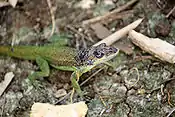 |
| Whiptails (Teiidae) | |||
| Species | Common name(s) | Notes | Image |
| Kentropyx borckiana | Guyana kentropyx, Guyana tegu | The only Kentropyx species found in the Eastern Caribbean. Only females are known to exist; the species as a whole is believed to consist only of unisexual clones.[5] Primarily found in central parishes; reported as locally common in St. Thomas and St. George.[6] | |
| Microteiids (Gymnophthalmidae) | |||
| Species | Common name(s) | Notes | Image |
| Gymnophthalmus underwoodi | Underwood's spectacled tegu | ||
| Skinks (Scincidae) | |||
| Species | Common name(s) | Notes | Image |
| Mabuya mabouya[7] | Regional endemic. Possibly extirpated from Barbados. | 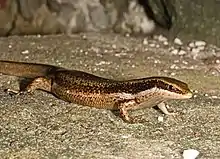 | |
| Worm snakes (Typhlopidae) | |||
| Species | Common name(s) | Notes | Image |
| Leptotyphlops carlae[8] | Barbados threadsnake | Endemic. First described in 2008; specimens were previously described as L. bilineatus.[9] The world's smallest known snake. | 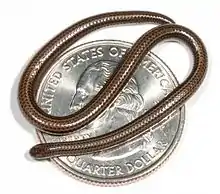 |
| Indotyphlops braminus | Brahminy blind snake, flowerpot blind snake | Recently introduced; apparently widespread.[10] | 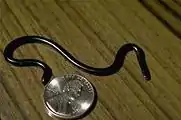 |
| Colubrids (Colubridae) | |||
| Species | Common name(s) | Notes | Image |
| Liophis perfuscus | Barbados racer, tan ground snake | Endangered. Endemic. Possibly extinct, as a confirmed sighting has not been made since 1961.[11] | |
| Mastigodryas bruesi | Barbour's tropical racer | Recently introduced, possibly through banana shipments. Originally native to Saint Vincent and Grenada.[12] | |
See also
Notes
- Malhotra & Thorpe 1999, p. 97.
- Conservation status, where available, is from the IUCN Red List and is indicative of the status of the species as a whole, not just populations on Barbados.
- See discussion of E. johnstonei in Government of Barbados 2002, p. 61.
- Government of Barbados 2002, p. 55.
- See Cole et al. 1995. Also extant in northern South America; incorrectly described as endemic to Barbados in Malhotra & Thorpe 1999, p. 97.
- Government of Barbados 2002, p. 55
- See Government of Barbados 2002, p. 55. Incorrectly listed in Malhotra & Thorpe 1999 as M. bistriata, a species often confused with M. mabouya.
- See Hedges 2008 for the first description of this species.
- L. bilineatus is reported in Malhotra & Thorpe 1999, p. 98; Government of Barbados 2002, p. 55 states only that its "status is unknown. L. bilineatus is now described as endemic to Martinique.
- Hedges 2008, p. 9.
- Government of Barbados 2002, p. 55
- Powell & Henderson 2005, p. 73. Government of Barbados 2002, p. 55 states that it was likely introduced by accident thirty years ago from Saint Vincent, and that an "incomplete specimen" was confused for L. perfuscus. Reported in Malhotra & Thorpe 1999, p. 98 only as "a new species of the genus Mastigodryas.".
References
Note: All species listed above are supported by Malhotra & Thorpe 1999 and Government of Barbados 2002, unless otherwise cited.
- Government of Barbados (2002), A National Biodiversity Strategy & Action Plan for Barbados, archived from the original on September 28, 2007, retrieved March 5, 2010.
- Cole, Charles J.; Dessauer, Herbert C.; Townsend, Carol R.; Arnold, Margaret G. (1995), Kentropyx borckiana (Squamata, Teiidae): a unisexual lizard of hybrid origin in the Guiana region, South America. American Museum Novitates; no. 3145, New York, N.Y: American Museum of Natural History.
Fields, Angela and Julia A. Horrocks An Annotated Checklist of the Herpetofauna of Barbados Journal of the Barbados Museum & Historical Society Vol 55 pp 263-283 2009
- Hedges, S. Blair (2008), "At the lower size limit in snakes: two new species of threadsnakes (Squamata: Leptotyphlopidae: Leptotyphlops) from the Lesser Antilles" (PDF), Zootaxa, 1841: 1–30, retrieved March 5, 2010
- Malhotra, Anita; Thorpe, Roger S. (1999), Reptiles & Amphibians of the Eastern Caribbean, Macmillan Education Ltd., pp. 97–98, ISBN 0-333-69141-5.
- Powell, Robert; Henderson, Robert W. (2005), "Conservation Status of Lesser Antillean Reptiles" (PDF), Iguana, 12 (2): 63–77
